Create sustainable solid perfumes by using beeswax or candelilla wax as your base, paired with carrier oils like jojoba or sweet almond. Store your creations in upcycled vintage tins, lockets, or glass jars. Use the double boiler method for safe melting, and add essential oils once cooled. Source ingredients locally, implement a refill program, and choose reusable containers. Focus on pulse points for application. These foundational tips will set you up for a zero-waste perfume journey.
Essential Ingredients for Natural Solid Perfumes
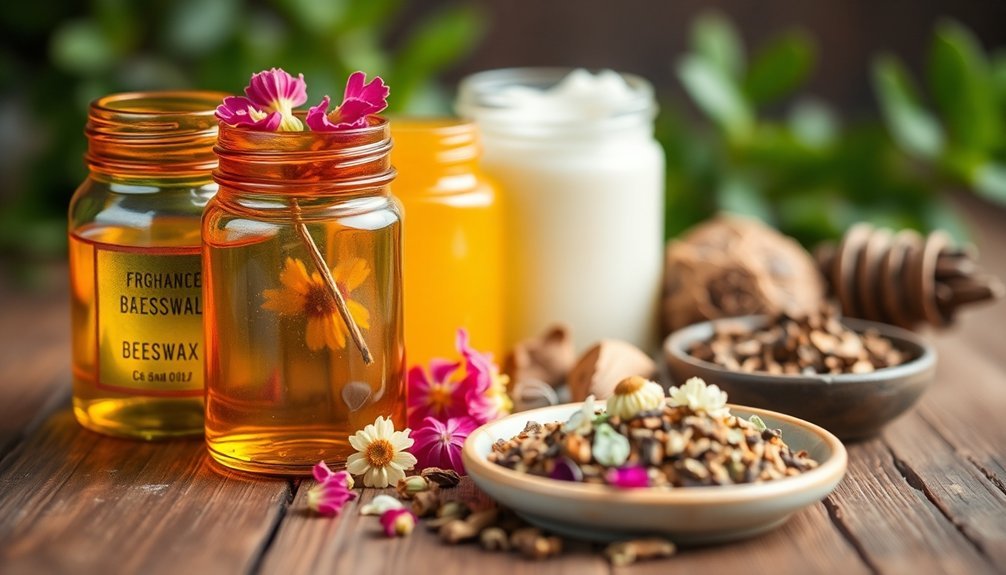
Aspiring perfumers can create their own natural solid fragrances using a few key ingredients that serve as the foundation for any blend.
Start with beeswax pellets, which provide the solid structure and contribute a subtle, earthy undertone. If you're following a vegan path, candelilla wax offers an excellent alternative.
You'll need a carrier oil to blend your fragrances. Sweet almond oil works well with its mild scent and skin-nourishing properties, while jojoba oil provides a completely neutral base that won't compete with your chosen scents.
For a lighter texture, consider fractionated coconut oil. These base ingredients create the perfect canvas for adding essential oils, allowing you to craft unique, sustainable fragrances that align with zero-waste principles. Apply the finished product to key pulse points for optimal scent release throughout the day.
Selecting Eco-Friendly Containers and Storage
When choosing containers for your solid perfumes, consider both glass and metal options, as they're durable, reusable, and perfect for maintaining fragrance integrity.
You can breathe new life into vintage tins, antique compacts, or small glass jars by thoroughly cleaning and sanitizing them before using them as eco-friendly perfume containers. Opt for sustainable options that complement the zero waste perfume movement while preserving your fragrances effectively.
Store your solid perfumes in these upcycled containers away from direct sunlight and heat, preferably in a cool, dry place to preserve their scent and consistency.
Glass Versus Metal Options
Selecting the right container for your solid perfume requires careful consideration of both glass and metal options, each offering distinct advantages for eco-conscious consumers.
Glass containers provide a luxurious look and can be recycled infinitely without quality loss, though they're more fragile and typically cost more. They're also excellent for maintaining scent integrity but require careful handling during transport.
Metal containers offer superior durability and portability, making them ideal if you're creating travel-sized products. They're generally more cost-effective and lightweight, with options like aluminum being fully recyclable. Both container types can be used to create personalized gifts with custom fragrance blends.
While they mightn't match glass's premium appearance, metal containers can be finished in various attractive styles.
Consider your priorities: if elegance and infinite recyclability are paramount, choose glass; if durability and affordability matter most, opt for metal.
Vintage Container Upcycling Tips
Breathing new life into vintage containers offers an enchanting way to store your solid perfumes while championing sustainability.
Old lockets and face cream jars make perfect vessels for your handcrafted fragrances, adding a touch of nostalgia while reducing waste. You'll find these containers not only protect your perfumes but also serve as conversation pieces.
When selecting vintage containers for your solid perfumes, consider these key factors:
- Look for containers with secure closures to preserve fragrance
- Choose items that are easy to clean and sanitize
- Select materials that won't react with your perfume ingredients
- Opt for smaller containers to maintain fragrance freshness
- Consider pieces that complement your personal style
Remember to store your vintage-contained perfumes in a cool, dark place to maintain their quality and extend their lifespan.
Proper Storage Techniques
The success of your solid perfume collection largely depends on choosing the right eco-friendly containers and storage solutions.
Opt for containers made from recycled metals or bioplastics, and guarantee they're certified non-toxic or biodegradable by recognized environmental organizations.
Store your solid perfumes in cool, dry conditions away from direct sunlight to maintain their integrity.
You'll want to use dark or tinted containers to protect the fragrances from light damage.
Consider implementing a modular shelving system with recycled materials to organize your collection efficiently.
For labeling, stick to plant-based inks or biodegradable stickers to maintain your zero-waste commitment.
Keep track of your inventory by creating an organized system that includes expiration dates.
Using stackable storage maximizes space while preventing compression of your solid perfumes.
Melting and Blending Techniques for Perfect Consistency
Creating perfectly blended solid perfumes requires mastering the delicate art of melting and combining ingredients at just the right temperatures.
You'll want to use a double boiler method for the safest results, keeping your heat-resistant equipment ready. When melting your chosen waxes, maintain a low, consistent temperature to protect their beneficial properties.
- Add beeswax first, as it has the highest melting point
- Blend in carnauba or candelilla wax for extra stability
- Cool the mixture slightly before adding essential oils
- Test the consistency by dropping a small amount onto a cool surface
- Adjust the texture with carrier oils if needed
Creating Unique Scent Combinations
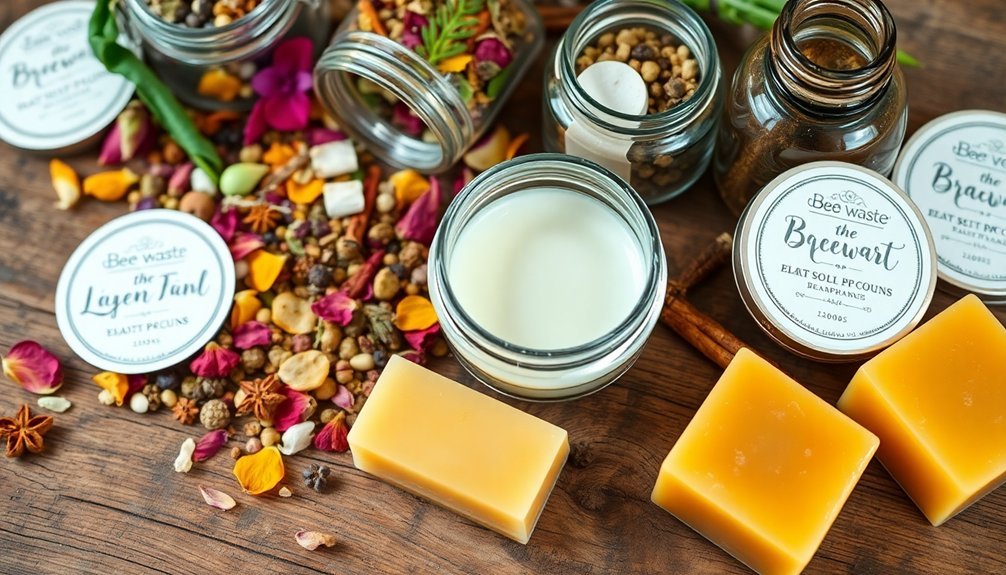
You'll find endless possibilities when layering essential oils, starting with a base note like vanilla and building up to lighter citrus or floral top notes.
Your seasonal fragrance choices can range from warm, spicy blends in winter to bright, citrus-forward combinations in summer.
Try experimenting with different oil ratios and take notes on which combinations work best for your personal preferences.
Layering Essential Oil Blends
While traditional perfumes rely on pre-mixed scents, layering essential oils lets you craft personalized fragrances with depth and complexity. Start with base notes like sandalwood, then add middle notes such as lavender, and finish with light top notes like lemon.
You'll want to massage each layer into your skin before adding the next, allowing the oils to interact naturally with your body.
For the best layering experience:
- Begin and end with a carrier oil to protect your skin and enhance absorption
- Choose single-species oils rather than pre-made blends for better control
- Apply to pulse points like wrists and neck for targeted effects
- Experiment with different ratios to find your perfect scent combination
- Consider adding fixative oils like cedarwood to extend fragrance longevity
Seasonal Fragrance Families
Each season brings its own distinct fragrance palette, inviting you to craft unique scent combinations that capture nature's ever-changing moods. You'll find spring bursting with floral and green notes, while summer dances with citrus and light jasmine. Autumn wraps you in warm spices and earthy undertones, and winter delivers deep, smoky woods with sophisticated florals.
| Season | Primary Notes | Complementary Notes |
|---|---|---|
| Spring | Rose, Lavender | Fresh Herbs, Bergamot |
| Autumn | Cinnamon, Vanilla | Patchouli, Apple |
| Winter | Cedar, Iris | Black Pepper, Leather |
When creating your zero-waste solid perfumes, you can blend contrasting notes for added depth. Try pairing warm spices with cool citrus, or deep florals with light aquatic notes. Don't forget that versatile ingredients like vanilla work beautifully across multiple seasons.
Maximizing Fragrance Longevity Without Synthetics
Since natural fragrances often fade more quickly than their synthetic counterparts, maximizing their longevity requires strategic application and thoughtful ingredient selection.
You'll find that proper application techniques and storage methods greatly enhance your natural perfume's staying power.
To maximize your fragrance's longevity without synthetic additives:
- Apply to well-moisturized skin, focusing on pulse points for ideal scent projection
- Choose formulations with concentrated woodsy base notes, which naturally last longer
- Layer complementary scents to create a more complex and enduring fragrance profile
- Store your perfumes in cool, dark places with tight-fitting caps to prevent degradation
- Consider using solid perfumes in reusable containers, as they tend to have better staying power than liquid forms
These natural approaches help maintain your scent throughout the day while supporting your zero-waste goals.
Upcycling and Repurposing Packaging Materials
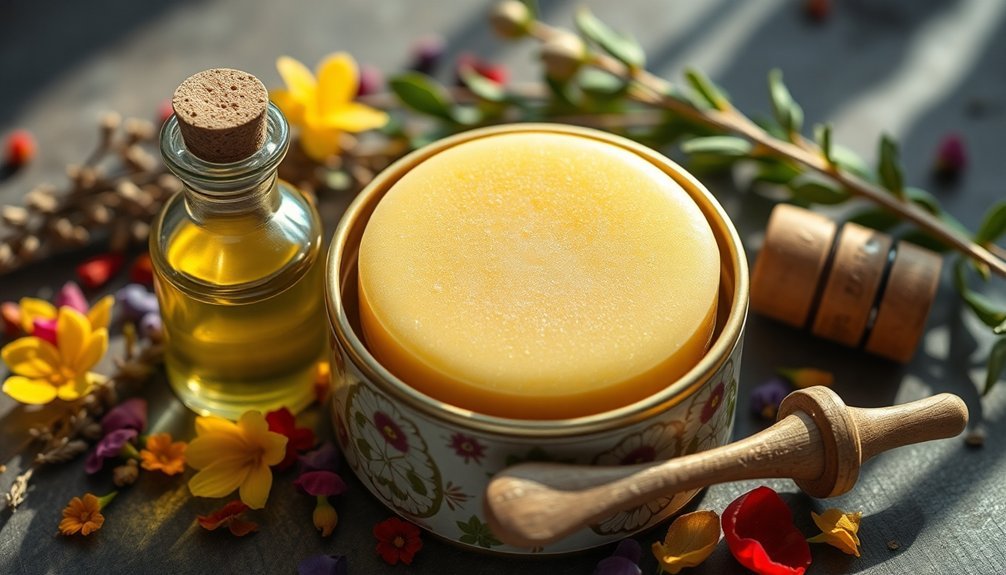
Transform your empty mint tins, vintage compact cases, and small jewelry boxes into stylish containers for your solid perfumes, giving these items a second life while reducing waste.
You'll find creative potential in glass jars from beauty products, which can be thoroughly cleaned and decorated with sustainable materials like twine, pressed flowers, or recycled paper.
These repurposed containers not only protect your solid perfumes but also add a personal touch to your zero-waste beauty routine.
Creative Container Ideas
Three creative container options can revolutionize your solid perfume storage while supporting zero-waste goals. Transform vintage lockets into portable perfume cases, repurpose old tea tins for practical storage, or convert antique boxes for a touch of nostalgia.
You'll find these options both cost-effective and environmentally conscious.
For more innovative storage solutions, consider these versatile options:
- Old watch cases that offer elegant, compact storage
- Repurposed makeup compacts combining style with functionality
- Vintage pillboxes perfect for travel-sized portions
- Cleaned mini jam jars for a sustainable choice
- Decorative keychains that keep your perfume within easy reach
These creative containers not only reduce waste but also add unique character to your solid perfumes while making them conveniently portable.
Recycled Packaging Solutions
Innovative recycling solutions can dramatically reduce the environmental impact of your solid perfume packaging. You'll find that many biodegradable materials and 100% recyclable glass containers are now readily available for your creations.
Consider using repurposed metal tins or upcycled vintage containers that add unique charm while minimizing waste.
When selecting packaging for your solid perfumes, look for options made from recycled ocean plastic or other reclaimed materials. You can also clean and refurbish existing perfume bottles, giving them new life.
Opt for minimal designs that use fewer materials overall, and choose plastic-free caps whenever possible.
Decorative Tin Transformations
Creative restoration breathes new life into old tin containers, making them perfect vessels for your solid perfumes.
You'll discover endless possibilities for transforming these durable metal containers into personalized packaging that's both sustainable and stylish. Whether you're using alcohol inks, washi tape, or paint, you can create unique designs that reflect your personality.
Transform your tins with these decorative techniques:
- Apply swirling patterns with alcohol inks for a watercolor effect
- Wrap coordinating washi tape designs around the edges
- Create textured surfaces through metal embossing
- Add custom labels to identify your fragrances
- Paint intricate designs using metallic or matte finishes
You're not just making beautiful containers; you're contributing to zero-waste practices while saving money.
These transformed tins are perfect for travel and offer leak-proof protection for your solid perfumes.
Incorporating Dried Flowers and Herbs
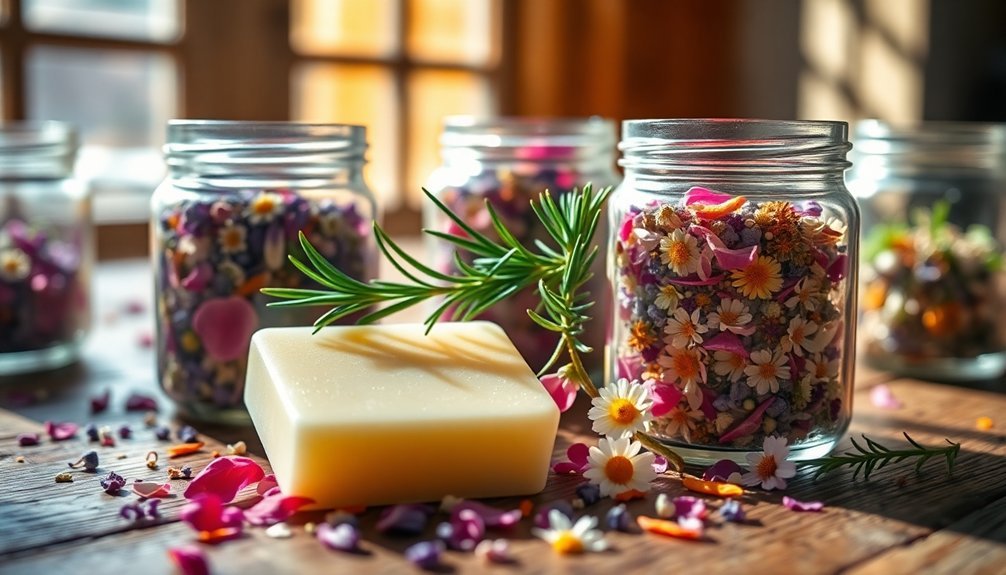
When crafting zero-waste solid perfumes, dried flowers and herbs serve as natural enhancers that elevate both the fragrance and visual appeal of your creations. You'll find these botanical elements not only add subtle, chemical-free scents but also contribute therapeutic properties like chamomile's calming effects.
| Flower/Herb | Benefits | Best Uses |
|---|---|---|
| Jasmine | Romantic scent | Evening perfumes |
| Chamomile | Calming properties | Relaxation blends |
| Lavender | Soothing aroma | All-purpose scents |
| Rose petals | Floral notes | Feminine fragrances |
| Garden herbs | Fresh accents | Custom blends |
Source your materials from local tea shops or grow them in your garden for maximum sustainability. When preparing, clean thoroughly and infuse them in oil for several weeks, shaking regularly to distribute the scent. Store your creations in reusable tins or vintage lockets to maintain your zero-waste commitment.
Mastering the Double Boiler Method
After selecting your botanical ingredients, the next step in creating zero-waste solid perfumes involves proper melting techniques. You'll need to master the double boiler method to safely melt your waxes and oils. Set up a glass or steel bowl over a saucepan of simmering water, ensuring the bowl doesn't touch the water's surface.
- Use a thermometer to monitor temperature and keep water below boiling.
- Choose carrier oils like jojoba or sweet almond for their skin benefits.
- Heat ingredients on low to medium, stirring occasionally until fully melted.
- Remove from heat immediately once wax has liquified.
- Add essential oils quickly and stir thoroughly before pouring.
Don't rush the process – proper temperature control is vital for a successful blend.
Once mixed, pour your perfume into containers and let it cool undisturbed for the best results.
Sustainable Sourcing of Raw Materials
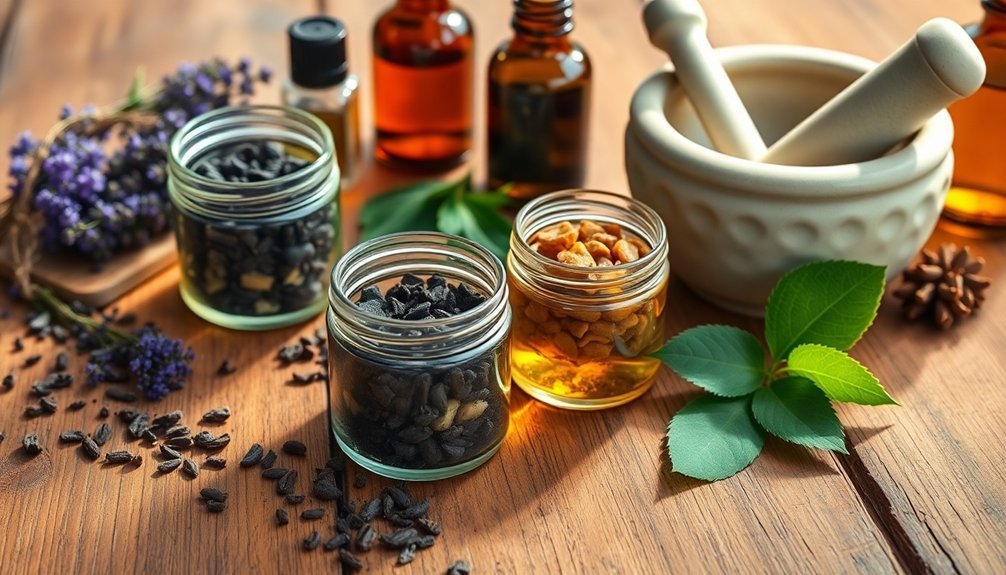
Sustainable sourcing lies at the heart of creating truly eco-friendly solid perfumes. When selecting your raw materials, opt for natural and organic ingredients that support local communities and protect biodiversity.
Look for suppliers who use sustainable extraction methods like steam distillation and cold pressing.
Sustainable extraction techniques ensure your perfume ingredients maintain their natural properties while minimizing environmental impact.
You'll want to guarantee transparency in your sourcing process by researching each ingredient's origin and environmental impact.
Consider working with certified suppliers who hold Ecocert or similar sustainability certifications. These certifications verify that your ingredients meet organic standards and ethical sourcing practices.
Remember that choosing locally sourced materials whenever possible reduces your carbon footprint and supports regional ecosystems.
Connect with local farming communities who can provide high-quality, sustainably harvested botanicals for your solid perfume creations.
Creative Gift Packaging Solutions
Three essential elements define eco-friendly gift packaging for solid perfumes: creativity, sustainability, and style.
You'll find endless possibilities for packaging your handcrafted solid perfumes using materials you already have at home. Transform glass jars, vintage tins, or cardboard tubes into stunning containers that'll impress your recipients while staying true to zero-waste principles.
- Wrap your solid perfume containers in furoshiki fabric for an elegant, reusable presentation.
- Decorate kraft paper with dried flowers and herbs that complement your perfume's scent.
- Repurpose vintage maps or sheet music for a unique, artistic wrapping solution.
- Use burlap bags for a rustic touch, perfect for gift sets.
- Create custom explosion boxes with compartments for different perfume varieties.
Consider adding natural elements like dried petals or sustainable washi tape to enhance your packaging's appeal.
Frequently Asked Questions
How Long Does a Solid Perfume Typically Last Before the Scent Starts Fading?
You'll notice your solid perfume's scent lasting 3-4 hours on average, but it'll depend on your skin chemistry, application method, and environmental factors. You may need to reapply throughout the day.
Can Solid Perfumes Cause Stains on Clothing or Fabric?
Yes, solid perfumes can stain your clothes, especially since they contain oils and waxes. You'll want to let them dry on your skin before dressing and avoid direct contact with fabrics.
What's the Shelf Life of Homemade Solid Perfumes?
Your homemade solid perfume will typically last 6-12 months when you store it properly. You'll get the best shelf life by keeping it in an airtight container in a cool, dark place.
Are Solid Perfumes Tsa-Approved for Air Travel?
Yes, you'll have no issues bringing solid perfumes through TSA security. They're not subject to liquid restrictions, so you can pack them in your carry-on without counting toward your 3-1-1 liquid allowance.
Can I Melt and Reblend My Solid Perfume if I Don't Like the Scent?
Yes, you can melt and reblend your solid perfume. Use a double boiler to carefully melt it, adjust the fragrance to your liking, and let it cool properly to maintain the right texture.

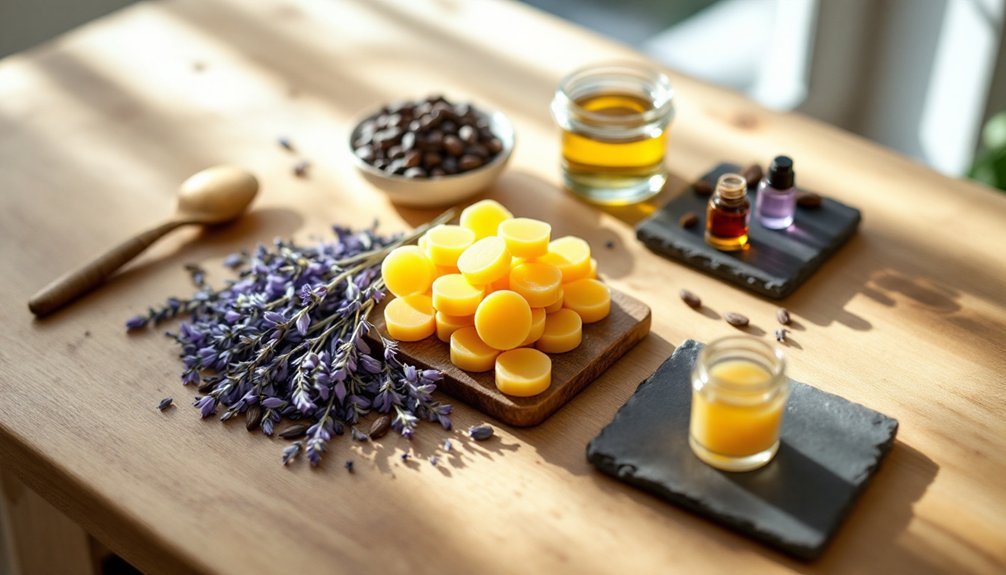
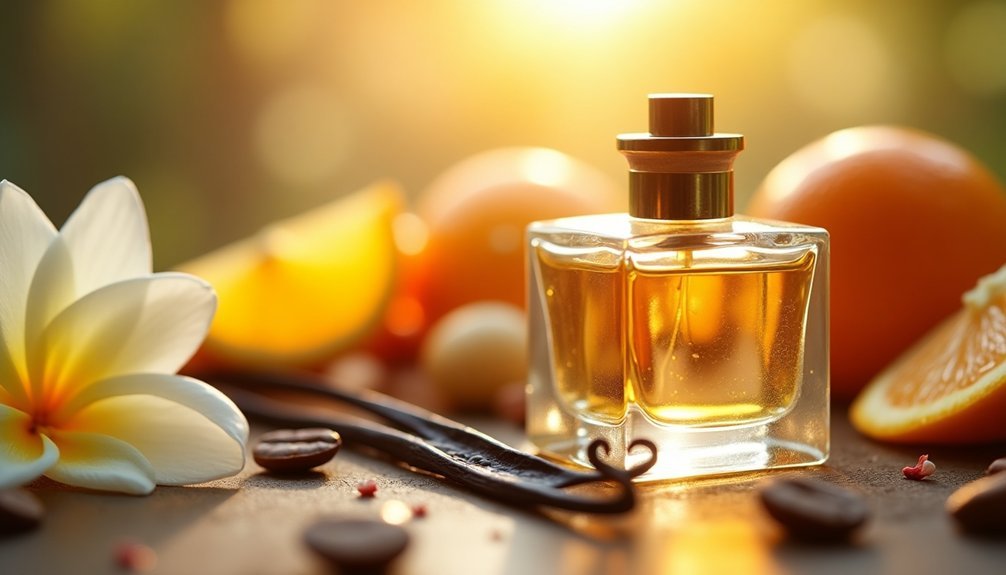

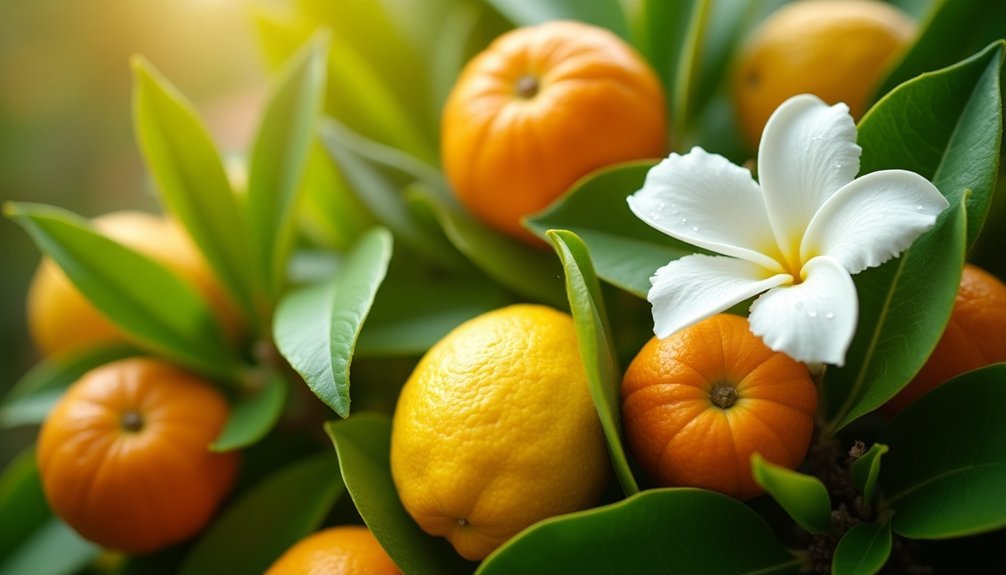
Leave a Reply